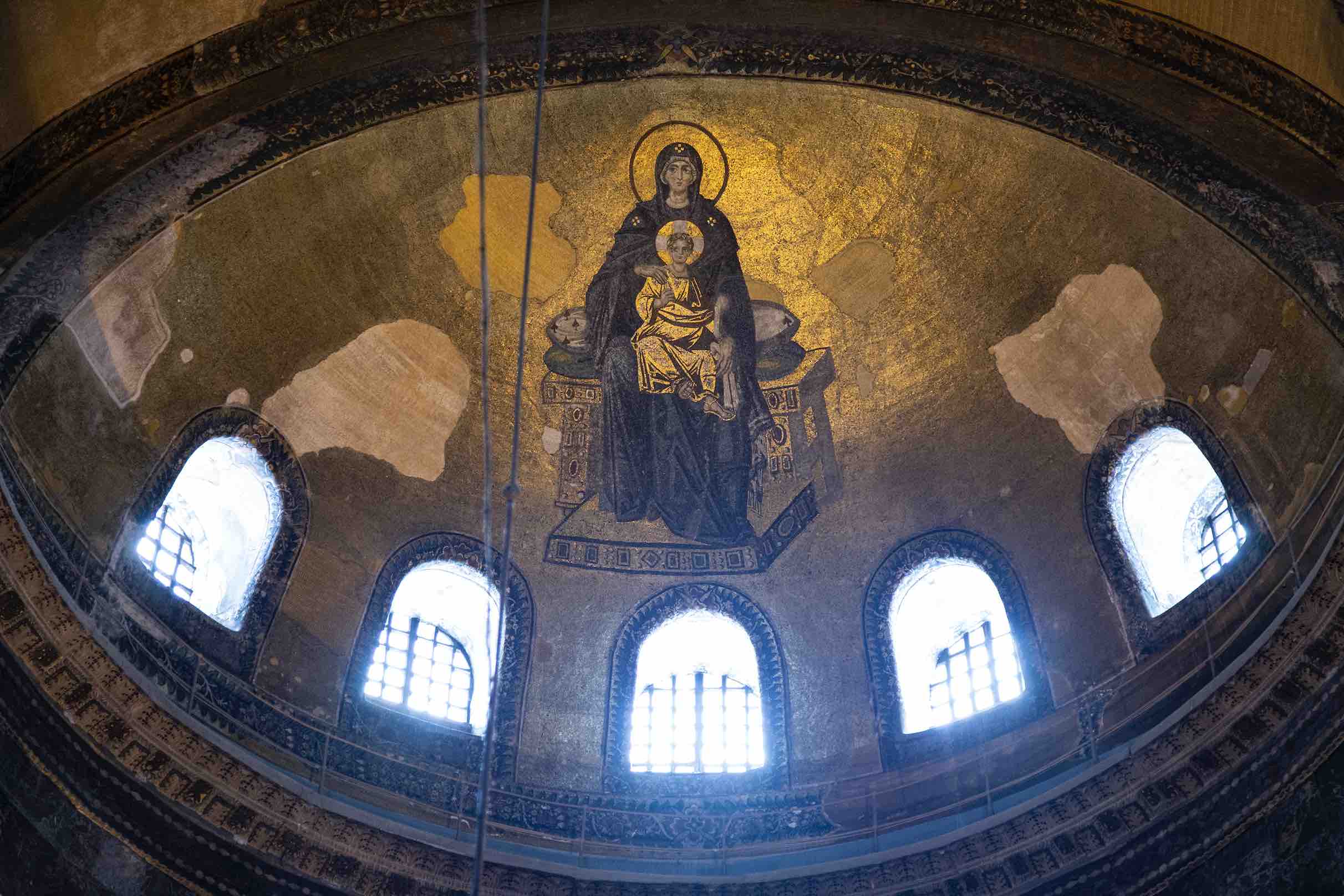2
Dr. Evan Freeman
What is an icon?
In our time, we often refer to celebrities as cultural icons, pop icons, and fashion icons. Rebels are sometimes labeled iconoclasts. Icons are also the little images that populate the screens of our computers, phones, and tablets, which we click to open files and apps.
The word “icon” comes from the Greek eikо̄n, so, “icon” simply means image. In the Eastern Roman “Byzantine” Empire and other lands that shared Byzantium’s Orthodox Christian faith, “holy icons” were images of sacred figures and events.
When art historians talk about icons today, they often mean portraits of holy figures painted on wood panels with encaustic or egg tempera, like this tempera icon of Christ from fourteenth-century Thessaloniki. But the Byzantines used the term icon more broadly, as this statement made by Church authorities in 787 C.E. shows:
Holy icons—made of colors, pebbles, or any other material that is fit—may be set in the holy churches of God, on holy utensils and vestments, on walls and boards, in houses and in streets. These may be icons of our Lord and God the Savior Jesus Christ, or of our pure Lady the holy Theotokos [“Theotokos” is a Greek term for the Virgin Mary that means “God-bearer”], or of honorable angels, or of any saint or holy man.
– Council of Nicaea II, 787 C.E.
*
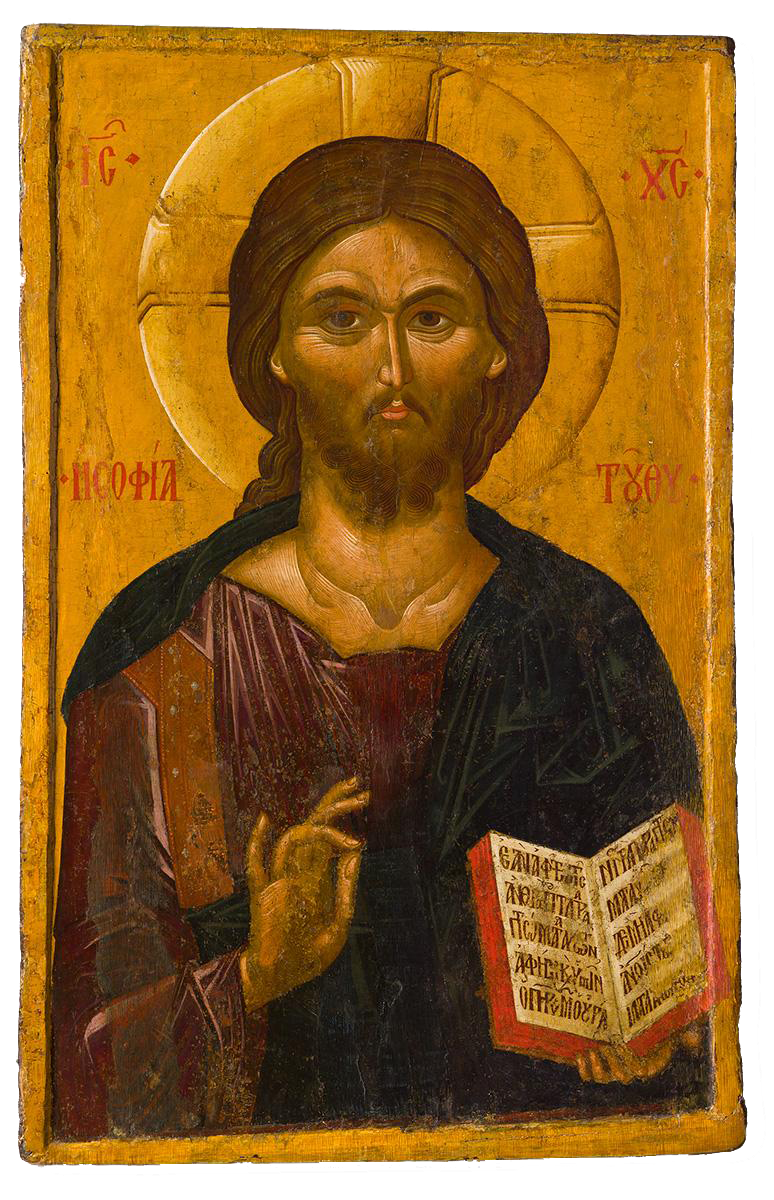
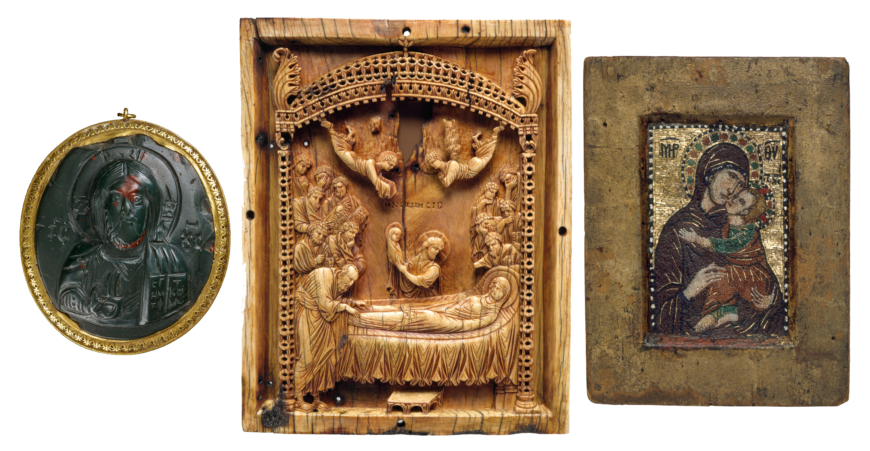
*
*
In Byzantium, icons were painted, but they were also carved in stone and ivory and fashioned from mosaics, metals, and enamels—virtually any medium available to artists.
Icons could be monumental or miniature. They were located in a variety of religious and non-religious settings, including as decoration on functional objects like this Eucharistic chalice. (The Eucharist is the Christian offering and blessing of bread and wine, which are then consumed as the body and blood of Christ.)
And icons could depict a wide range of sacred subjects, such as Christ, the saints, and events from the Bible or the lives of saints.
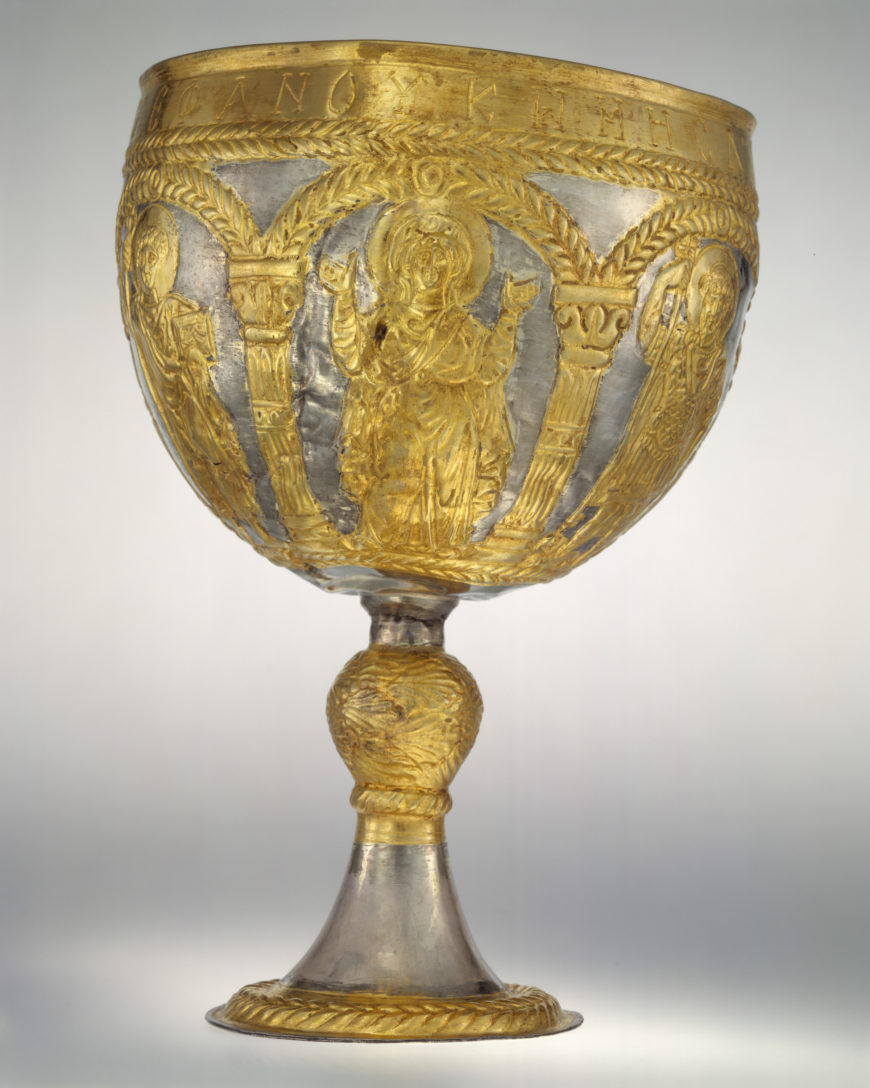
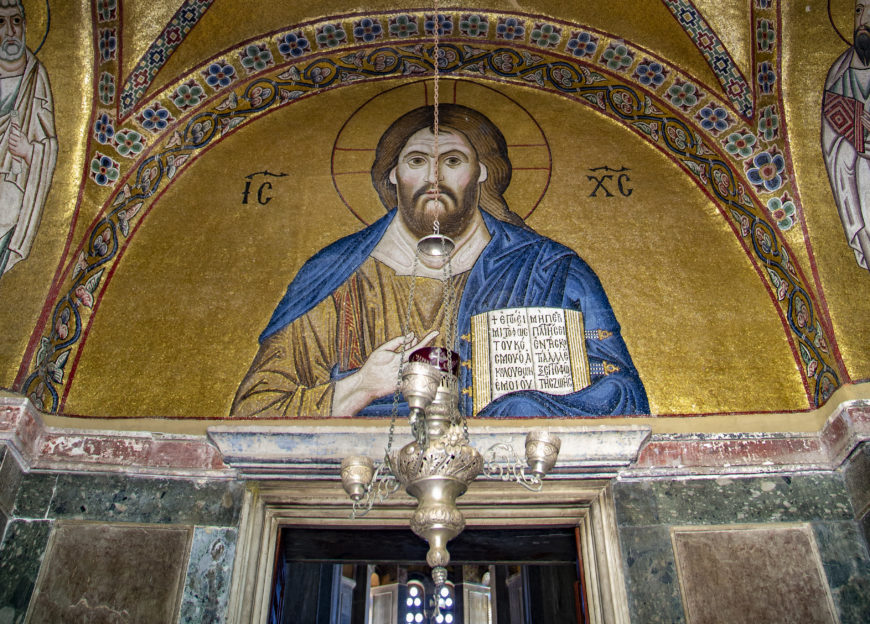
Iconoclasm and the “Triumph of Orthodoxy”
Christians initially disagreed over whether religious images were good or bad. Texts from as early as the second and third century describe some Christians using religious images, which they illuminated and adorned with garlands, but these practices were not universal or standardized. Church authorities often criticized these practices, which reminded them of customs associated with pagan Greece and Rome, where images of gods and emperors were widely venerated.
By the eighth and ninth centuries, icons were increasingly popular, and arguments about religious images boiled over in what is called the “Iconoclastic Controversy.” The so-called “iconoclasts” (literally, “breakers of images”) opposed icons, arguing that God was transcendent and could not be depicted in art. The iconoclasts feared that Christians praying before icons were worshipping inanimate objects.
On the other hand, the “iconophiles” (literally “lovers of images”), also known as “iconodules” (literally “servants of images”), defended icons, arguing that since Jesus, the Son of God, was born with a visible human body, he could be depicted in images.
*
The iconophiles maintained that rather than worshipping inanimate objects, they honored icons as a means of honoring the holy figures represented in icons.
Imperial and Church authorities in favor of icons gathered at a council in the city of Nicaea (modern İznik, Turkey, an ancient city in northwestern Anatolia) in 787 to try to resolve the controversy, but it was not until 843 that the Church definitively affirmed the use of images, ending the Iconoclastic Controversy in what became known as the “Triumph of Orthodoxy.”
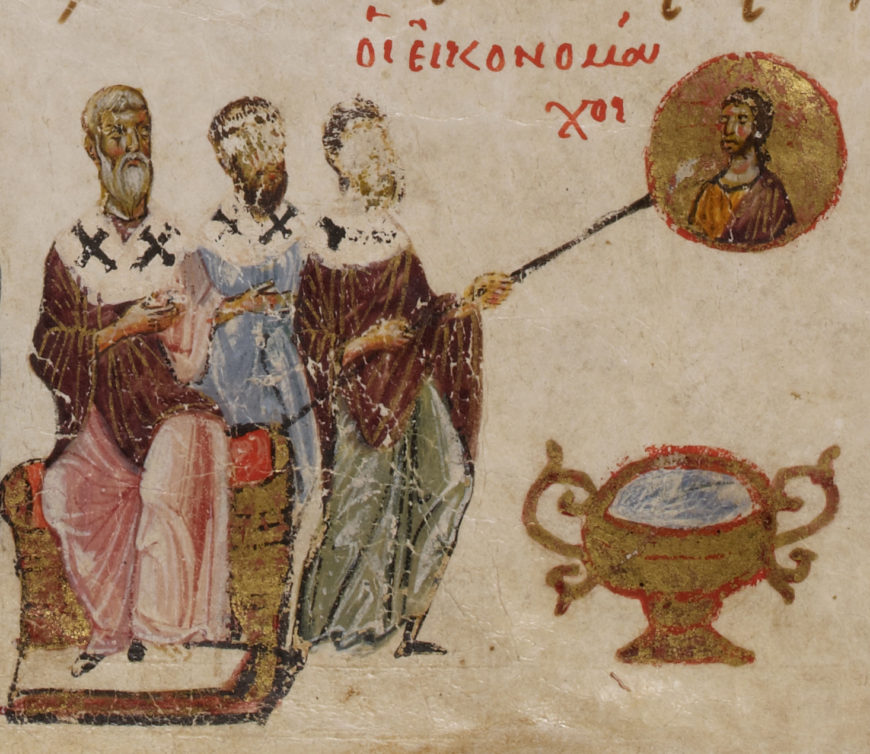
To this day, icons continue to play important roles in the faith and worship of the Eastern Orthodox Church, which is heir to the religious tradition of Byzantium. (The Orthodox Church is the second largest Christian community after the Roman Catholic Church. Christianity split between Orthodoxy in the East and Roman Catholicism in the West in 1054, an event known as the Great Schism.)
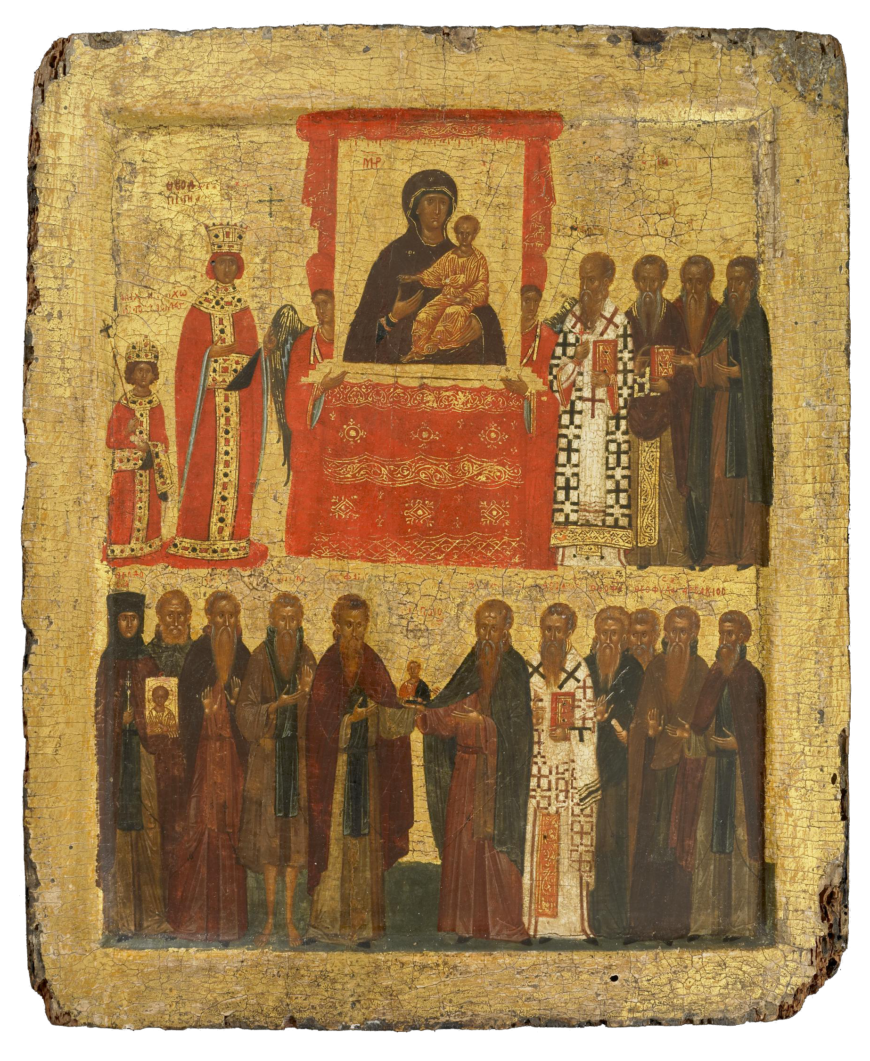
In addition to affirming Christian images, the 787 Council of Nicaea II and subsequent 843 Triumph of Orthodoxy also enshrined devotional practices associated with icons. Christians should bow before and kiss icons, light candles and lamps, and burn incense before them. All of these acts of devotion directed at images were intended to pass to the holy figures represented. As a modern analogy, we might consider the ways many people frame and hang photos of loved ones in their homes, sometimes even embracing or kissing such images.
Reading icons
Today, many people identify art with creativity and self-expression. But this was not always the case. Icons were meant to represent historical figures and Christian teaching in a manner that was recognizable and understandable for viewers. Since icons were venerated as a way of showing devotion to the figure represented, understanding who was depicted was particularly important. To achieve this, artists often relied on established artistic conventions.
For example, Saints Peter and Paul appear much the same through the centuries: Peter is an old man with white wavy hair and a short beard; Paul has balding, brown hair and a pointy beard. Modern viewers may dismiss such repetition as unoriginal. For viewers familiar with these conventions, the figures in icons were immediately recognizable, like seeing the faces of old friends.
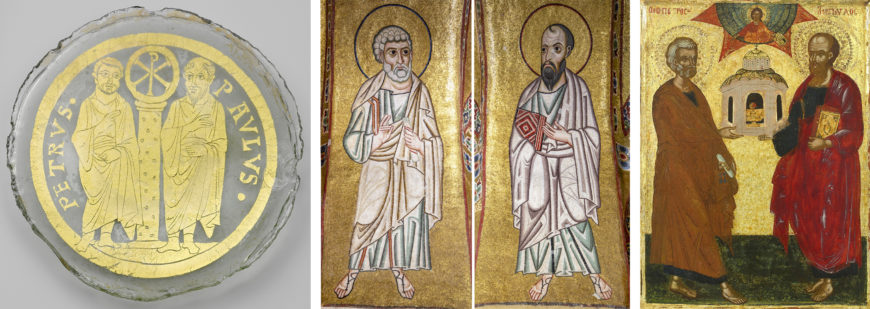

Artists also used what art historians call “iconographic attributes” to identify figures. For example, evangelists (authors of the Gospels) often hold Gospel books. Clergy saints wear church vestments and hold liturgical objects, such as censers, which were used by the clergy in church services. (The term “clergy” refers to church leaders; in Byzantium, the three major orders of the clergy were the bishops, priests, and deacons.) Healer saints hold boxes of medicine. Martyrs—saints who had died for their faith —often hold crosses to associate their sacrifice with the death of Christ on the cross.These attributes helped identify the holy figures represented. But there were no rulebooks governing these conventions, so iconographic attributes were subject to change. It was only in the post-Iconoclastic period, for example, that artists regularly depicted soldier saints in military garb, as seen in this tenth- or eleventh-century ivory icon of Saint Demetrios.
Another way of guaranteeing that viewers recognized the figures in icons was by including texts that labeled the icon’s subjects. Although labels were sporadic before Iconoclasm, they became normative in the post-Iconoclastic era. So, icons of Christ are labeled “IC XC” (the Greek abbreviation for “Jesus Christ”). Icons of the Virgin Mary are labeled “MP ΘY” (the Greek abbreviation for “Mother of God”).
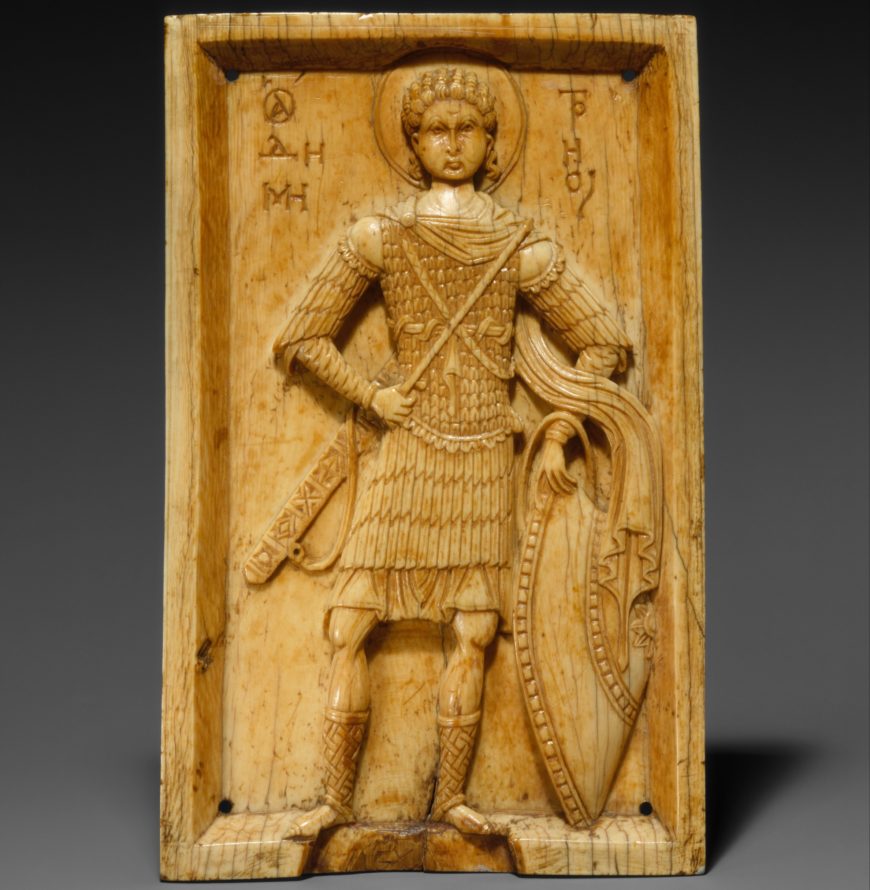
*
Icons of most other holy figures are labeled ὁ ἅγιος (o agios, meaning “saint,” or more literally, “holy”), sometimes abbreviated with as an “Α” within an “Ο” as seen in this tenth- or eleventh-century ivory icon of Saint Demetrios.
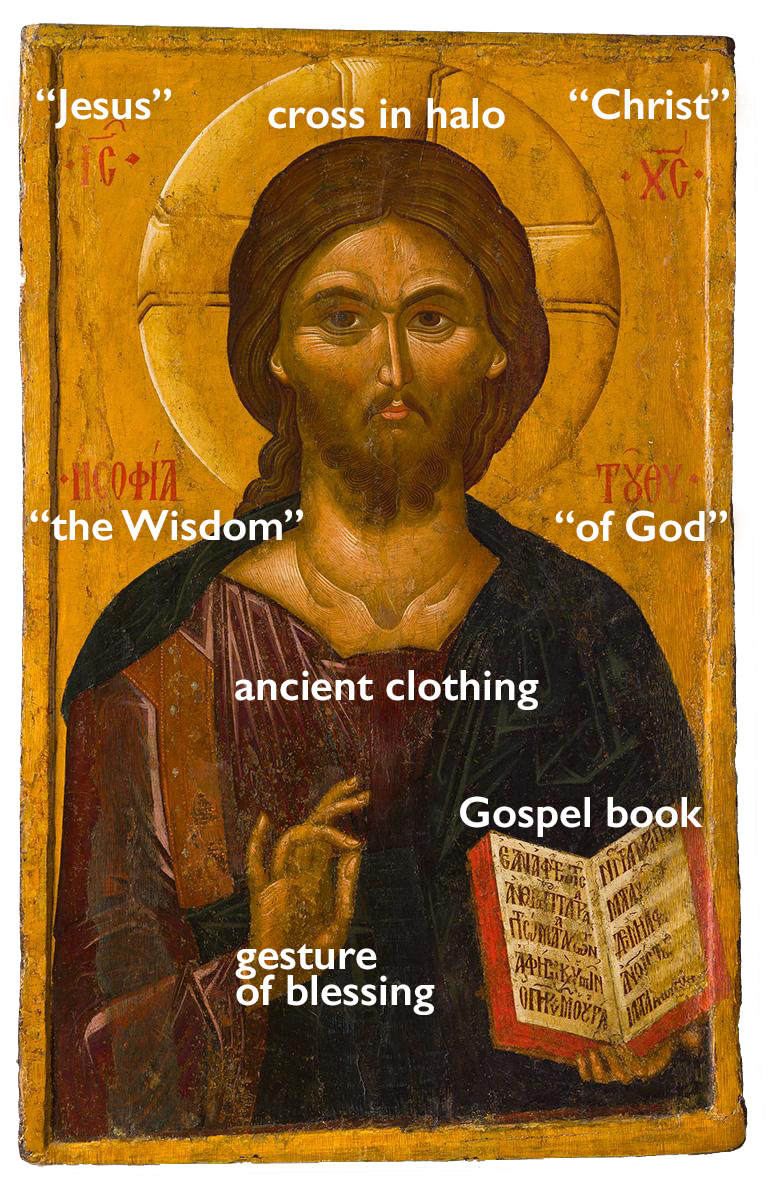
Consider how these elements work together in this late-fourteenth-century icon of Christ. Christ appears with his conventional long brown hair and beard. Iconographic attributes describe him further: The artist has sought to portray Christ in clothing from the ancient era in which he lived; Christ holds a Gospel book displaying his own words from Matthew 6:14–15; and there is a cross in Christ’s halo because he was crucified to save the world. Finally, the text identifies this as “Jesus Christ,” and also includes a more particular title: “the Wisdom of God.” Together, all these elements enabled Byzantine viewers to recognize the figure who gazed out and blessed them.
Variety and creativity
While the use of artistic conventions, attributes, and inscriptions made icons recognizable through the centuries, it would be wrong to suggest that all icons were the same. Icons varied based on the scale and medium in which they were depicted, as well as across periods and regions, where they were often the product of local materials, workshops, and tastes. Artists also regularly experimented with new compositions. Depictions of the Virgin and child, among the most popular subjects of Byzantine icons, took numerous forms through the centuries.
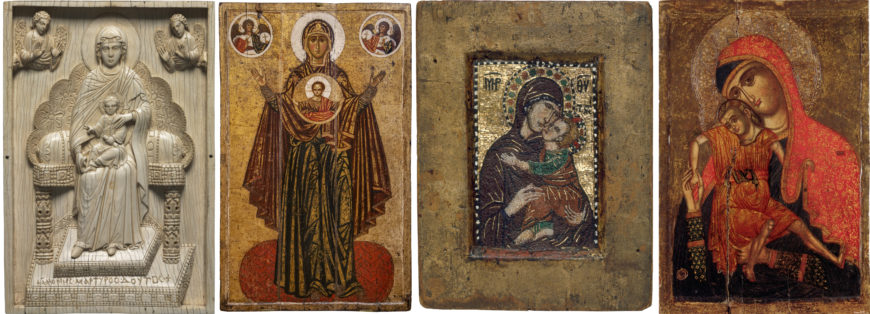
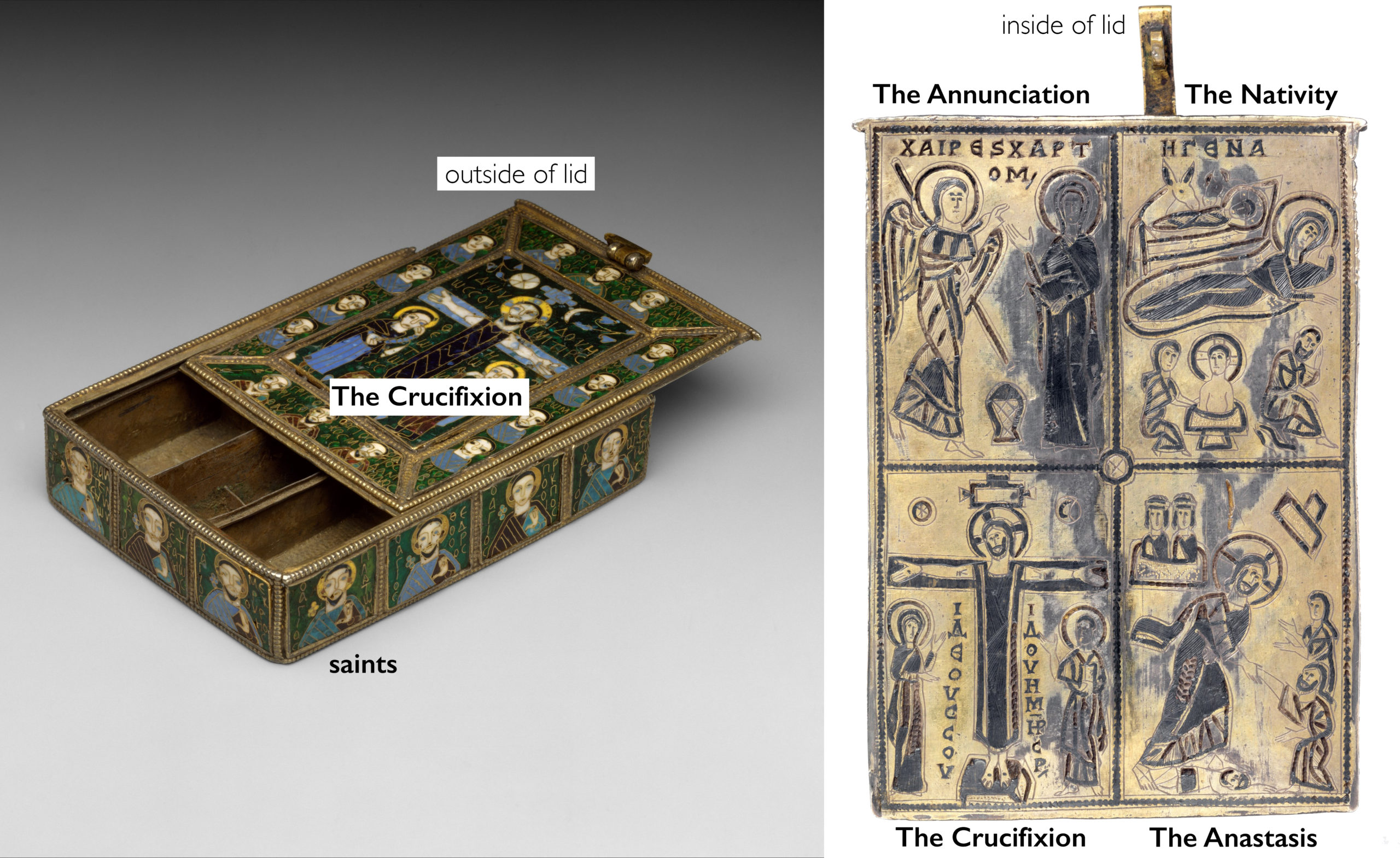
Sometimes, artists invented new images that were widely imitated. The Anastasis (Greek for “Resurrection”), which depicted Christ descending into Hades (the underworld) to raise the dead from their tombs, first appeared in the eighth century and has remained a common image in Orthodox churches to this day.
Another example, the tenth-century ivory Crucifixion at The Metropolitan Museum of Art, drew imagery from church hymnography (the poetic songs sung in Byzantine churches) to show Christ’s cross impaling a personification of Hades. It was apparently one of a kind; no comparable images survive. (See illustration below.)
*
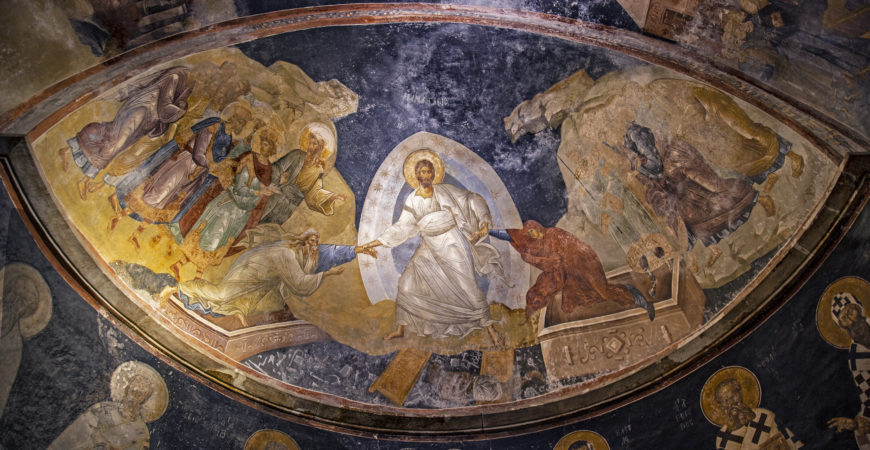
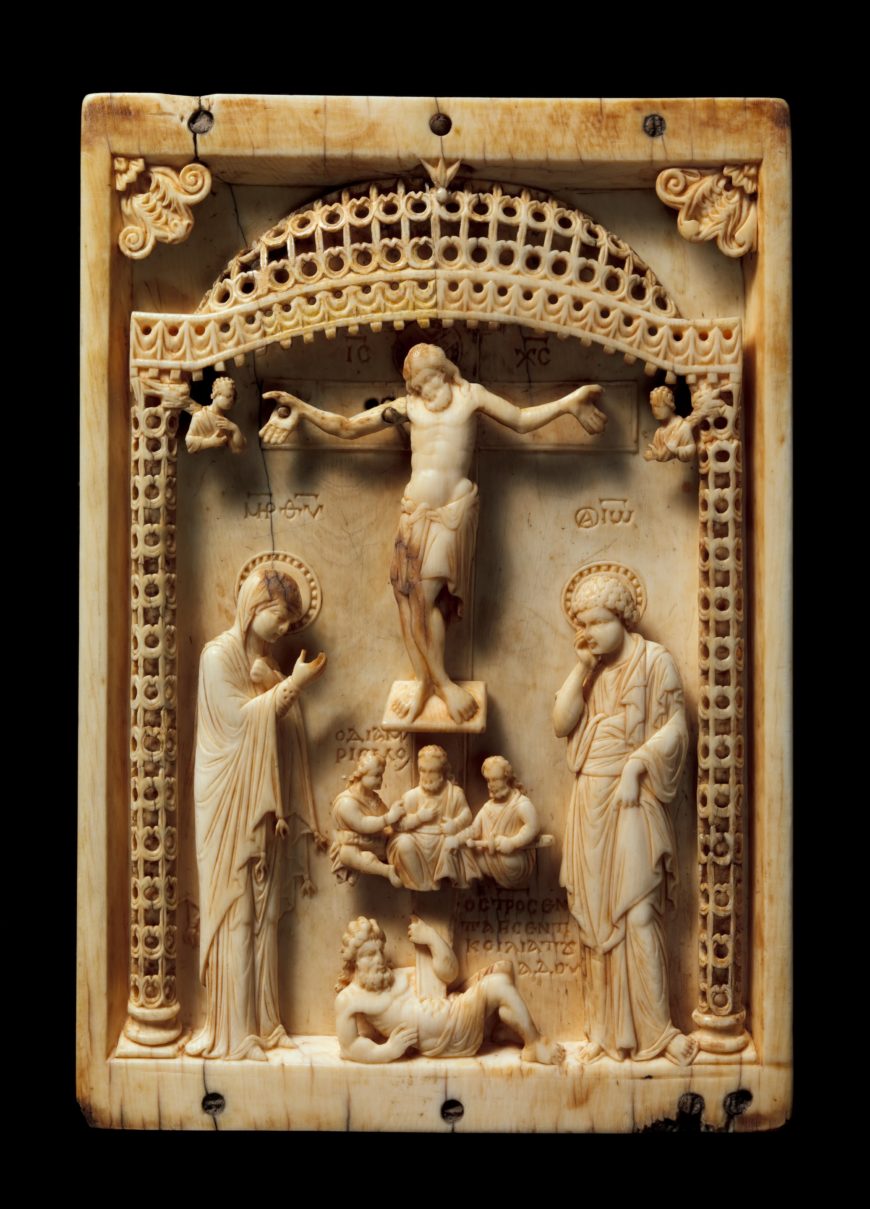
Functions of icons
Icons had a wide range of functions in Byzantium. Their readability enabled them to illustrate Biblical texts, hagiographies (written accounts of a saint’s life), and theological ideas. It was a truism in the middle ages that images functioned as “books for the illiterate.” Before the age of the printing press and inexpensive books, few people owned books, and many could not read. While biblical passages were read aloud in church services, icons offered visual depictions of biblical events that all could see whenever they entered a church.
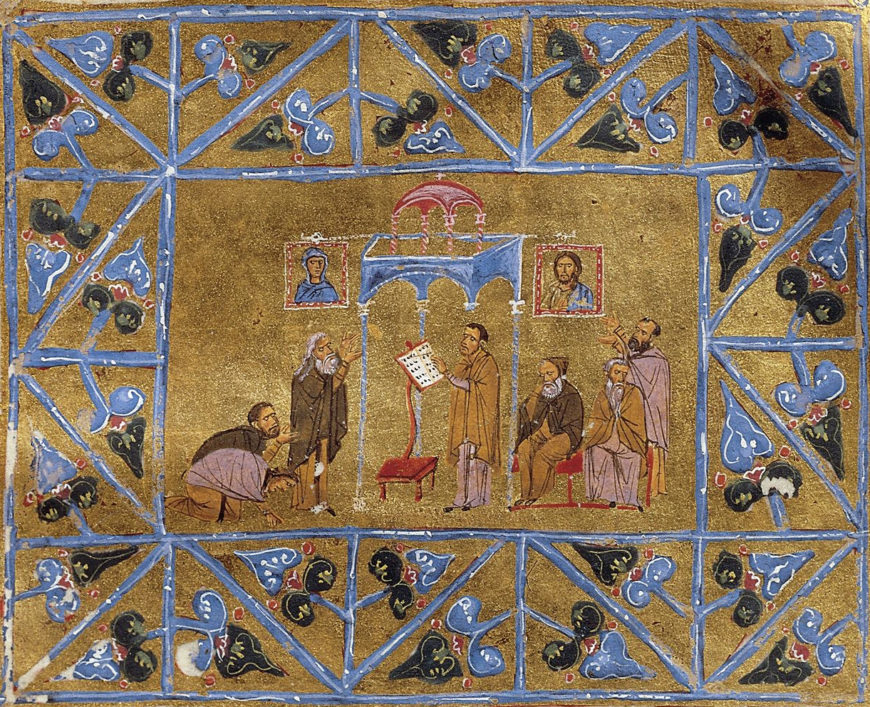
Icons also served as a focus for prayer and devotion, both in church services and in private settings. The frontality of portrait icons facilitated face-to-face encounters between holy figures and worshippers who wished to address the holy figures in prayer. The eleventh-century Theodore Psalter anachronistically imagines such an encounter between King David (from the Hebrew Bible) and a Byzantine icon of Christ.
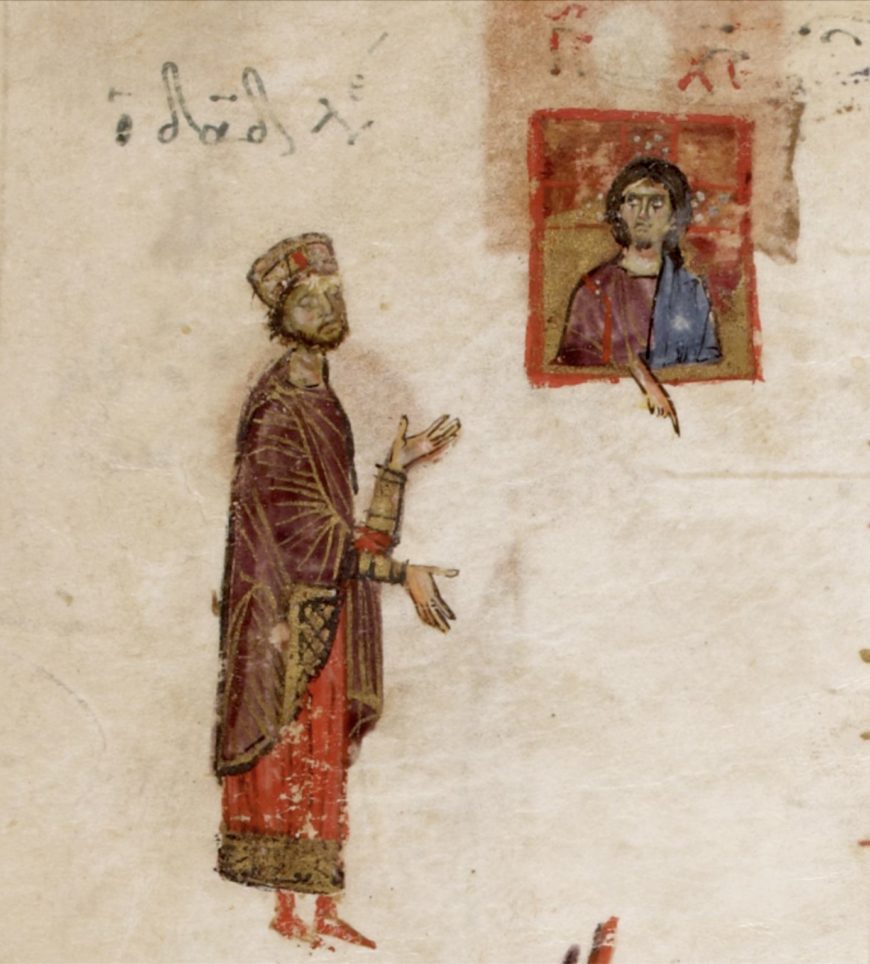

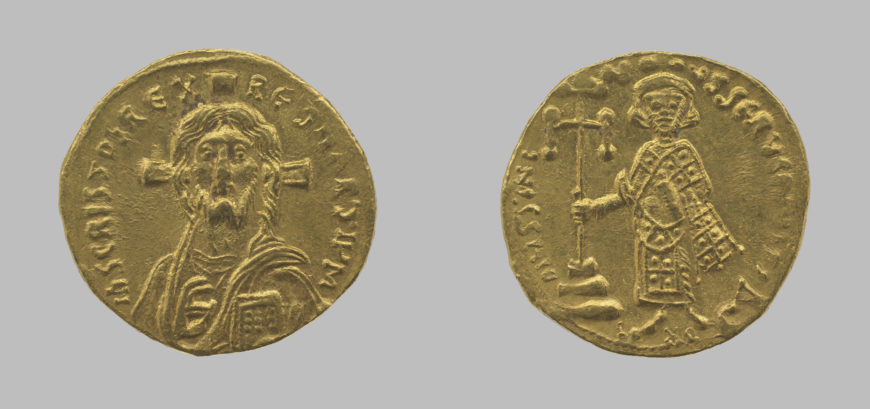
In many instances, the saints were believed to work miracles through their icons. Numerous Byzantine texts describe the figures in icons coming alive to defend or heal people. Icons could even be worn as jewelry, and inscriptions suggest that their wearers hoped these wearable icons would protect or heal them.
And in a culture with no notion of separation of church and state, icons frequently blurred the boundaries between religious and political imagery. Icons were carried in public processions, processed around city walls in times of distress, and even carried into battle. A fourteenth-century fresco at Markov Manastir in North Macedonia depicts both the Byzantine emperor and Church officials in procession with an icon of the Virgin and Child. In Hagia Sophia, the great cathedral of the Byzantine capital, mosaics depicted haloed emperors and empresses within the same frame as Christ and the Virgin. Icons of Christ even appeared on Byzantine coins during the reign of Justinian II around the turn of the eighth century, where God and emperor were literally on two sides of the same coin. (Emperor Justinian II reigned from 685–94 and again from 705–11.)

Adorning icons
Increasingly in the Late Byzantine periods, wealthy patrons affixed thin pieces of precious metal, or “revetments,” to icons as a way to honor the holy figures depicted. These metallic adornments often included ornamental motifs, additional icons, and sometimes even images of the patrons and poetic inscriptions known as epigrams, which recorded the donor’s prayers.
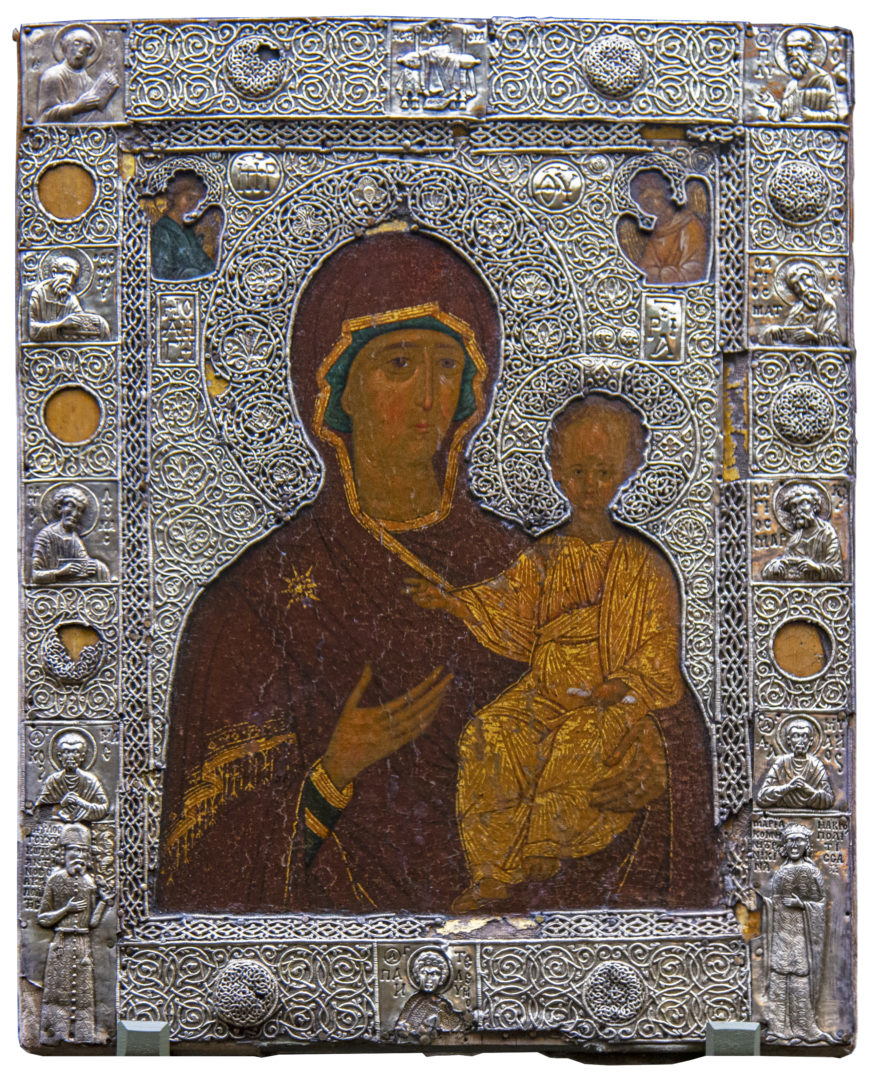
An icon in the Tretyakov Gallery in Moscow preserves silver revetment from thirteenth- or fourteenth-century Constantinople, although a later, fifteenth-century painting has replaced the original, which was likely lost or damaged. This revetment covers much of the wooden surface with a swirling filigree pattern, and smaller icons of various saints populate the icon’s frame. Two full-length portraits of the Byzantine donors appear in the lower corners of the frame.
After the fall of Byzantium to the Ottomans in 1453, the tradition of affixing precious materials to icons endured in places like Russia, where the icon cover was referred to as an oklad or riza. Russian oklads were often elaborate, covering the entire icon except for the face and hands of the holy figures represented, as seen with a seventeenth-century icon depicting the face of Christ at The Metropolitan Museum of Art.
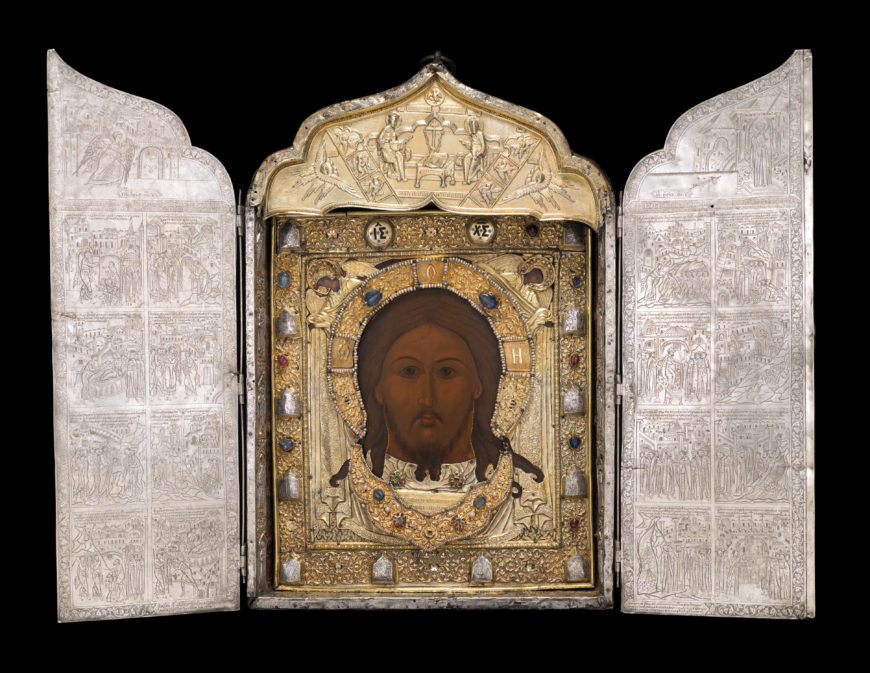
The modern “discovery” of icons
Use and the passage of time often left icons worn out or damaged. Icon varnish tended to darken with age, obscuring the icon’s image. In an age when modern restoration techniques did not yet exist, artists often painted directly over the darkened images so that an icon could be seen and used once again.
But at the turn of the twentieth century, new restoration techniques enabled conservators to uncover the original layers of many old, overpainted icons. In Russia, countless icons were stripped of oklads, darkened varnish, and layers of overpainting to reveal their original images. Such was the case with the fifteenth-century icon of the Trinity attributed to Andrew Rublev, restored in 1904 and again in 1918. While the restoration of Rublev’s Trinity revealed the brilliant colors and balanced composition of the original image, it also erased the many acts of devotion and overpainting that occurred through centuries, to which nail holes across the scarred surface of the image still attest. Walking through museums in Russia, one finds that many icons bear similar nail holes that once affixed oklads to the icons’ surfaces.
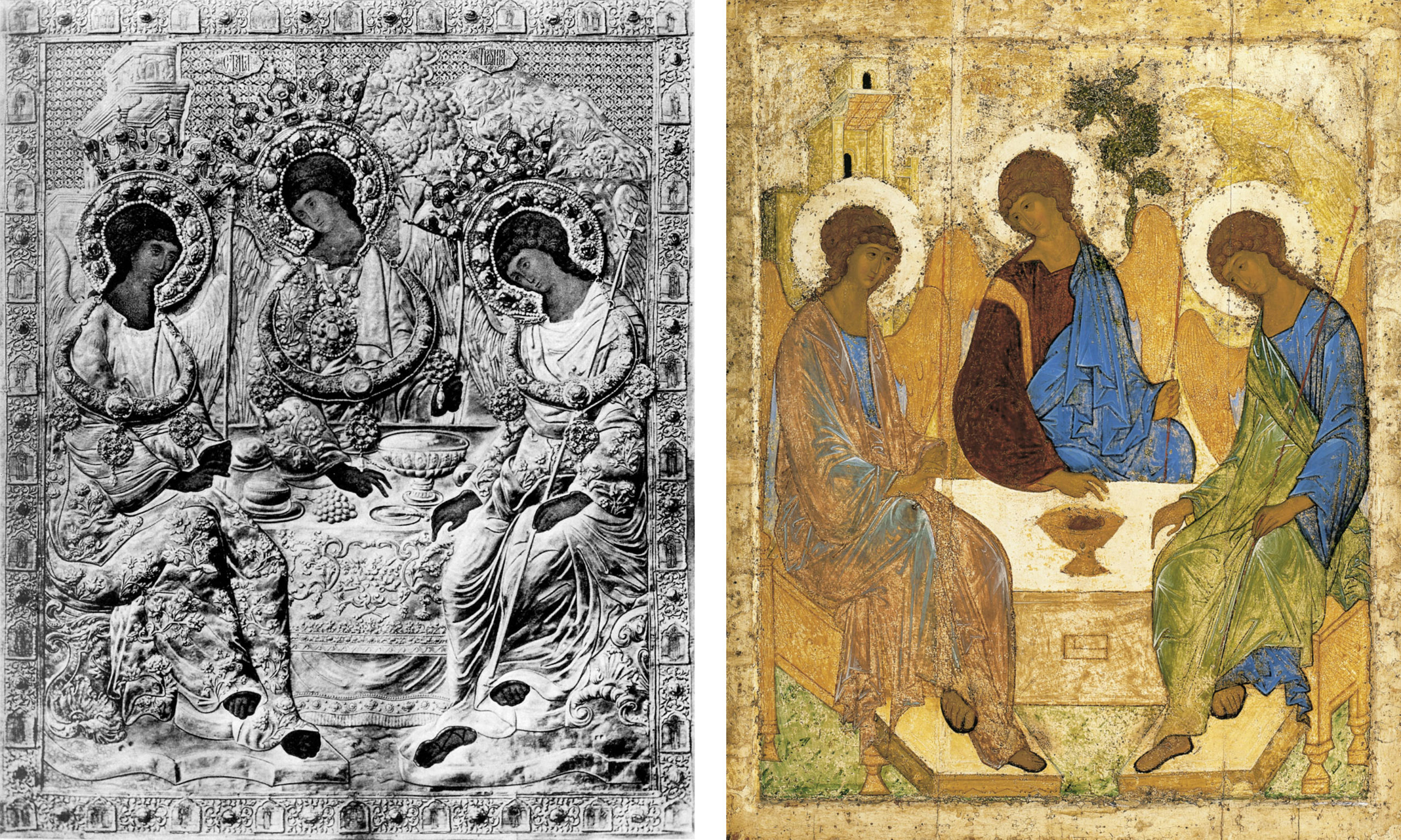
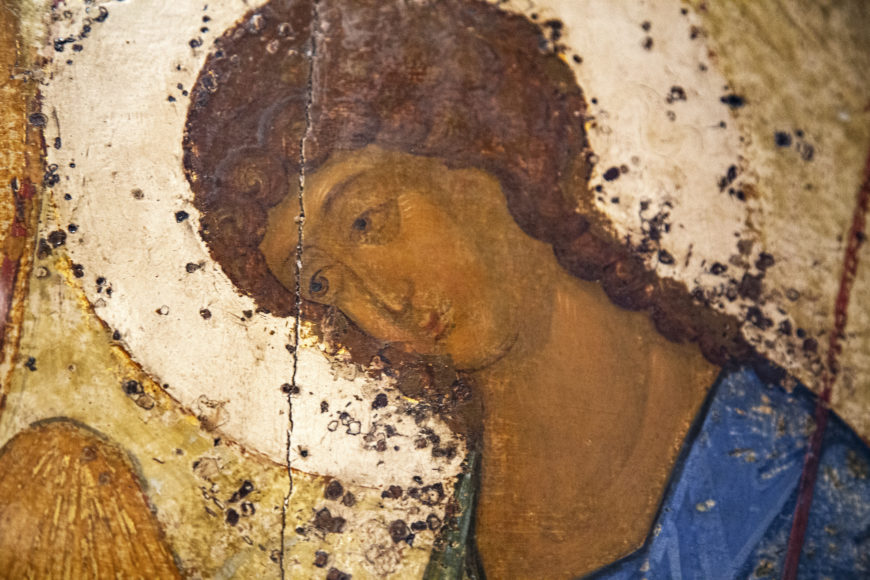
Many of Russia’s newly-restored icons were transferred from churches and exhibited in museums, which drastically changed the circumstances of their viewing. Such newly cleaned icons offered art historians valuable insights about the past and inspired modern artists in the present. After viewing an exhibition with icons in Russia in 1911, Henri Matisse famously commented: “French artists should come to study in Russia: Italy offers less in this field.”
Viewing icons then and now
Both the restoration of icons and their subsequent interpretation in the twentieth century were strongly influenced by modern tastes and theories of art. Today, the earliest painted image is prized, while the oklad is often dismissed as an ornamental addition that is foreign to the nature of the painted icon. Drawing parallels with modern art, art historians and critics like Clement Greenberg described icons as non-naturalistic, and many art historians have interpreted this aspect of icons as symbolizing spirituality and the figures in icons as distant from viewers.
More recently though, art historians have noted that the Byzantines consistently described the sacred figures in icons as accurate and lifelike.
Preaching in 867 about a new mosaic installed in the apse of Hagia Sophia following the Triumph of Orthodoxy over Iconoclasm, patriarch Photios, the leader of the Byzantine Church, stated:
With such exactitude has the art of painting, which is a reflection of inspiration from above, set up a lifelike imitation…You might think her not incapable of speaking, even if one were to ask her, “How didst thou give birth and remainest a virgin?” To such an extent have the lips been made flesh by the colors…Photios, Homily 17
Such texts remind us that the ways we view artworks are often highly contingent on our own cultural contexts.
